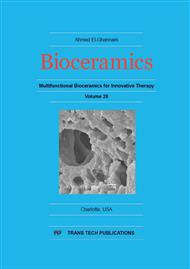[1]
S.V. Dorozhkin, Calcium orthophosphates (CaPO4): occurrence and properties, Prog. Biomater. 5 (2016) 9–70.
DOI: 10.1007/s40204-015-0045-z
Google Scholar
[2]
H. Li, J. He, H. Yu, C.R. Green, J. Chang, Bioactive glass promotes wound healing by affecting gap junction connexin 43 mediated endothelial cell behavior, Biomaterials. 84 (2016) 64–75.
DOI: 10.1016/j.biomaterials.2016.01.033
Google Scholar
[3]
I. Denry, L.T. Kuhn, Design and characterization of calcium phosphate ceramic scaffolds for bone tissue engineering, Dent. Mater. 32 (2016) 43–53.
DOI: 10.1016/j.dental.2015.09.008
Google Scholar
[4]
T. Furusawa, T. Minatoya, T. Okudera, Y. Sakai, T. Sato, Y. Matsushima, H. Unuma, Enhancement of mechanical strength and in vivo cytocompatibility of porous β-tricalcium phosphate ceramics by gelatin coating, Int. J. Implant. Dent. 2 (2016) 1–6.
DOI: 10.1186/s40729-016-0037-3
Google Scholar
[5]
A. Mina, A. Castaño, J.C. Caicedo, H.H. Caicedo, Y. Aguilar, Determination of physical properties for β-TCP and chitosan biomaterial obtained on metallic 316L substrates, Mater. Chem. Phys. 160 (2015) 296–307.
DOI: 10.1016/j.matchemphys.2015.04.041
Google Scholar
[6]
F. H. ElBatal, M.A. Ouis, H.A. ElBatal, Comparative studies on the bioactivity of some borate glasses and glass–ceramics from the two systems: Na2O–CaO–B2O3 and NaF–CaF2–B2O3, Ceram. Int. 42 (2016) 8247–8256.
DOI: 10.1016/j.ceramint.2016.02.037
Google Scholar
[7]
M. Montazerian, J.F. Schneider, B.E. Yekta, V. K. Marghussian, A.M. Rodrigues, E.D. Zanotto, Sol–gel synthesis, structure, sintering and properties of bioactive and inert nano-apatite–zirconia glass–ceramics, Ceram. Int. 41 (2015) 11024–11045.
DOI: 10.1016/j.ceramint.2015.05.047
Google Scholar
[8]
Y.X. Pang, X. Bao, Influence of temperature, ripening time and calcination on the morphology and crystallinity of hydroxyapatite nanoparticles, J. Eur. Ceram. Soc. 23 (2003) 1697–1704.
DOI: 10.1016/s0955-2219(02)00413-2
Google Scholar
[9]
K.C.B. Yeong, J. Wang, S.C. Ng, Mechanochemical synthesis of nanocrystalline hydroxyapatite from CaO and CaHPO4, Biomaterials. 22 (2001) 2705–2712.
DOI: 10.1016/s0142-9612(00)00257-x
Google Scholar
[10]
C. Bergmann, M. Lindner, W. Zhang, K. Koczur, A. Kirsten, R. Telle, H. Fischer, 3D printing of bone substitute implants using calcium phosphate and bioactive glasses, J. Eur. Ceram. Soc. 30 (2010) 2563–2567.
DOI: 10.1016/j.jeurceramsoc.2010.04.037
Google Scholar
[11]
S. Cai, G.H. Xu, X.Z. Yu, W.J. Zhang, Z.Y. Xiao, K.D. Yao, Fabrication and biological characteristics of ß-tricalcium phosphate porous ceramic scaffolds reinforced with calcium phosphate glass, J. Mater. Sci. Mater. Med. 20 (2009) 351–358.
DOI: 10.1007/s10856-008-3591-2
Google Scholar
[12]
M. Langer, F. Peyrin, 3D X-ray ultra-microscopy of bone tissue, Osteoporos. Int. 27 (2016) 441–455.
DOI: 10.1007/s00198-015-3257-0
Google Scholar
[13]
R. Cancedda, A. Cedola, A. Giuliani, V. Komlev, S. Lagomarsino, M. Mastrogiacomo, F. Peyrin, F. Rustichelli, Bulk and interface investigations of scaffolds and tissue-engineered bones by X-ray microtomography and X-ray microdiffraction, Biomaterials. 28 (2007).
DOI: 10.1016/j.biomaterials.2007.01.022
Google Scholar
[14]
G. Stanciu, I. Sandulescu, B. Savu, Investigation of the hydroxyapatite growth on bioactive glass surface, J. Biomed. & pharm. Eng. 1 (2007) 34–39.
Google Scholar
[15]
Q. Fu, M.N. Rahaman, B.S. Bal, R.F. Brown, Proliferation and function of MC3T3-E1 cells on freeze-cast hydroxyapatite scaffolds with oriented pore architectures, Mater. Sci. Eng. C. 29 (2009) 2147–2153.
DOI: 10.1007/s10856-008-3668-y
Google Scholar


